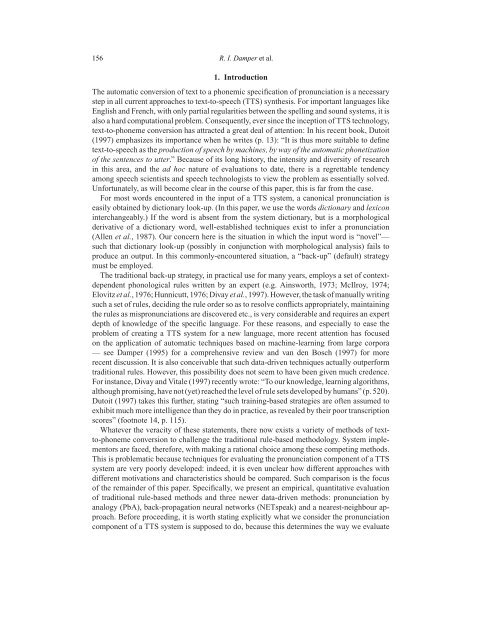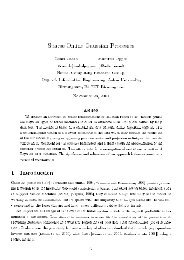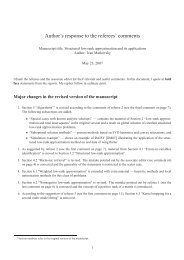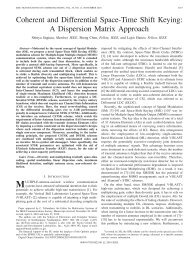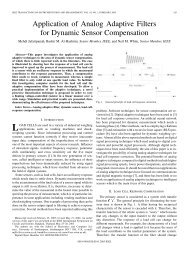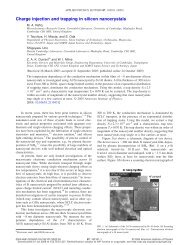Evaluating the pronunciation component of text-to-speech systems ...
Evaluating the pronunciation component of text-to-speech systems ...
Evaluating the pronunciation component of text-to-speech systems ...
You also want an ePaper? Increase the reach of your titles
YUMPU automatically turns print PDFs into web optimized ePapers that Google loves.
156 R. I. Damper et al.<br />
1. Introduction<br />
The au<strong>to</strong>matic conversion <strong>of</strong> <strong>text</strong> <strong>to</strong> a phonemic specification <strong>of</strong> <strong>pronunciation</strong> is a necessary<br />
step in all current approaches <strong>to</strong> <strong>text</strong>-<strong>to</strong>-<strong>speech</strong> (TTS) syn<strong>the</strong>sis. For important languages like<br />
English and French, with only partial regularities between <strong>the</strong> spelling and sound <strong>systems</strong>, it is<br />
also a hard computational problem. Consequently, ever since <strong>the</strong> inception <strong>of</strong> TTS technology,<br />
<strong>text</strong>-<strong>to</strong>-phoneme conversion has attracted a great deal <strong>of</strong> attention: In his recent book, Du<strong>to</strong>it<br />
(1997) emphasizes its importance when he writes (p. 13): “It is thus more suitable <strong>to</strong> define<br />
<strong>text</strong>-<strong>to</strong>-<strong>speech</strong> as <strong>the</strong> production <strong>of</strong> <strong>speech</strong> by machines, by way <strong>of</strong> <strong>the</strong> au<strong>to</strong>matic phonetization<br />
<strong>of</strong> <strong>the</strong> sentences <strong>to</strong> utter.” Because <strong>of</strong> its long his<strong>to</strong>ry, <strong>the</strong> intensity and diversity <strong>of</strong> research<br />
in this area, and <strong>the</strong> ad hoc nature <strong>of</strong> evaluations <strong>to</strong> date, <strong>the</strong>re is a regrettable tendency<br />
among <strong>speech</strong> scientists and <strong>speech</strong> technologists <strong>to</strong> view <strong>the</strong> problem as essentially solved.<br />
Unfortunately, as will become clear in <strong>the</strong> course <strong>of</strong> this paper, this is far from <strong>the</strong> case.<br />
For most words encountered in <strong>the</strong> input <strong>of</strong> a TTS system, a canonical <strong>pronunciation</strong> is<br />
easily obtained by dictionary look-up. (In this paper, we use <strong>the</strong> words dictionary and lexicon<br />
interchangeably.) If <strong>the</strong> word is absent from <strong>the</strong> system dictionary, but is a morphological<br />
derivative <strong>of</strong> a dictionary word, well-established techniques exist <strong>to</strong> infer a <strong>pronunciation</strong><br />
(Allen et al., 1987). Our concern here is <strong>the</strong> situation in which <strong>the</strong> input word is “novel”—<br />
such that dictionary look-up (possibly in conjunction with morphological analysis) fails <strong>to</strong><br />
produce an output. In this commonly-encountered situation, a “back-up” (default) strategy<br />
must be employed.<br />
The traditional back-up strategy, in practical use for many years, employs a set <strong>of</strong> con<strong>text</strong>dependent<br />
phonological rules written by an expert (e.g. Ainsworth, 1973; McIlroy, 1974;<br />
Elovitz et al., 1976; Hunnicutt, 1976; Divay et al., 1997). However, <strong>the</strong> task <strong>of</strong> manually writing<br />
such a set <strong>of</strong> rules, deciding <strong>the</strong> rule order so as <strong>to</strong> resolve conflicts appropriately, maintaining<br />
<strong>the</strong> rules as mis<strong>pronunciation</strong>s are discovered etc., is very considerable and requires an expert<br />
depth <strong>of</strong> knowledge <strong>of</strong> <strong>the</strong> specific language. For <strong>the</strong>se reasons, and especially <strong>to</strong> ease <strong>the</strong><br />
problem <strong>of</strong> creating a TTS system for a new language, more recent attention has focused<br />
on <strong>the</strong> application <strong>of</strong> au<strong>to</strong>matic techniques based on machine-learning from large corpora<br />
— see Damper (1995) for a comprehensive review and van den Bosch (1997) for more<br />
recent discussion. It is also conceivable that such data-driven techniques actually outperform<br />
traditional rules. However, this possibility does not seem <strong>to</strong> have been given much credence.<br />
For instance, Divay and Vitale (1997) recently wrote: “To our knowledge, learning algorithms,<br />
although promising, have not (yet) reached <strong>the</strong> level <strong>of</strong> rule sets developed by humans” (p. 520).<br />
Du<strong>to</strong>it (1997) takes this fur<strong>the</strong>r, stating “such training-based strategies are <strong>of</strong>ten assumed <strong>to</strong><br />
exhibit much more intelligence than <strong>the</strong>y do in practice, as revealed by <strong>the</strong>ir poor transcription<br />
scores” (footnote 14, p. 115).<br />
Whatever <strong>the</strong> veracity <strong>of</strong> <strong>the</strong>se statements, <strong>the</strong>re now exists a variety <strong>of</strong> methods <strong>of</strong> <strong>text</strong><strong>to</strong>-phoneme<br />
conversion <strong>to</strong> challenge <strong>the</strong> traditional rule-based methodology. System implemen<strong>to</strong>rs<br />
are faced, <strong>the</strong>refore, with making a rational choice among <strong>the</strong>se competing methods.<br />
This is problematic because techniques for evaluating <strong>the</strong> <strong>pronunciation</strong> <strong>component</strong> <strong>of</strong> a TTS<br />
system are very poorly developed: indeed, it is even unclear how different approaches with<br />
different motivations and characteristics should be compared. Such comparison is <strong>the</strong> focus<br />
<strong>of</strong> <strong>the</strong> remainder <strong>of</strong> this paper. Specifically, we present an empirical, quantitative evaluation<br />
<strong>of</strong> traditional rule-based methods and three newer data-driven methods: <strong>pronunciation</strong> by<br />
analogy (PbA), back-propagation neural networks (NETspeak) and a nearest-neighbour approach.<br />
Before proceeding, it is worth stating explicitly what we consider <strong>the</strong> <strong>pronunciation</strong><br />
<strong>component</strong> <strong>of</strong> a TTS system is supposed <strong>to</strong> do, because this determines <strong>the</strong> way we evaluate


